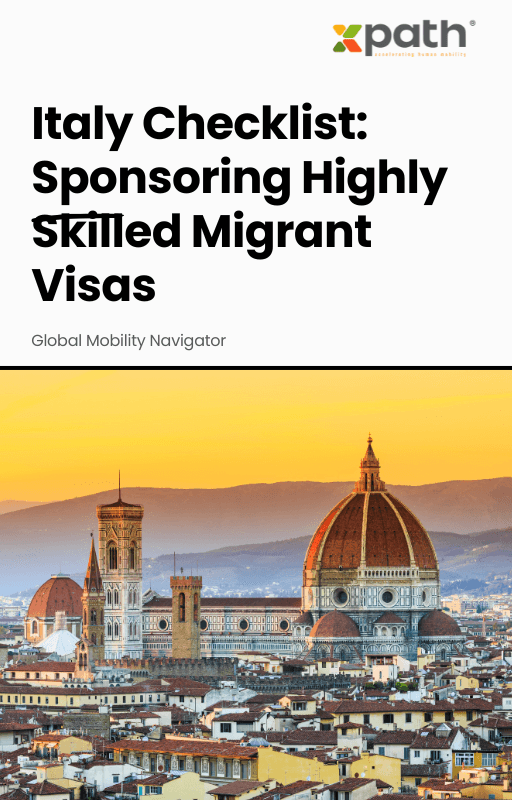Italy Checklist: Sponsoring Highly Skilled Migrant Visas
Grab a copy of a guide to international employee relocation
View E-bookHow do companies attract, develop, and retain the best talent in a world where borders are more virtual than physical? The spotlight is now on global mobility solutions—the unsung heroes ensuring organizations thrive in a borderless era. As more companies expand internationally and remote work becomes the norm, aligning global mobility with talent strategy is no longer a luxury but a necessity. Let’s dive deep into how this transformation is evolving, why you should care, and what you can do to leverage mobility solutions for sustainable growth.
For decades, “global mobility” conjured images of expatriate assignments, cross-border transfers, and complicated logistics. Fast-forward to today, and it’s a much bigger, faster, and more strategic engine. It’s about deploying the right talent to the right places—on-site, remote, or hybrid—anywhere in the world. The focus goes beyond relocation: it includes compliance, cultural integration, employee experience, and strategic workforce planning.
Research from Deloitte suggests that 88% of organizations now view mobility as critical to developing future leaders and fostering organizational agility. As traditional borders blur and talent pools become truly global, being able to deploy people seamlessly is now a central aspect of business resilience.
Let’s crunch some numbers. The EY Global Mobility Effectiveness Survey 2022 found that:
This marks a striking evolution. Companies are no longer sending employees abroad just for cost or skill gaps—they’re proactively using international mobility to attract, develop, and retain high performers. According to PwC’s Mobility 2025 report, organizations that sync mobility and talent functions see a 30% higher retention rate among global assignees. That’s not just impressive; it’s a competitive edge.
Case in point: Tech giant Microsoft revamped its global mobility policy, introducing flexible, employee-driven moves. The move resulted in a 25% bump in assignment satisfaction scores and accelerated leadership development programs.
Of course, with great opportunity comes real complexity. Keeping up with tax compliance, immigration rules, and evolving work-from-anywhere policies is like steering a ship through unpredictable storms. A survey by KPMG cites that 59% of mobility leaders struggle to balance policy flexibility with compliance requirements.
Beyond logistics, there’s the human factor. Employees want clear communication, smooth onboarding, family support, and a sense of belonging in remote or host locations. The companies winning at mobility aren’t just ticking boxes—they’re curating experiences. That entails integrated technology stacks, transparent processes, and local expertise—something platforms like xpath.global are purpose-built to provide.
Take a look at the financial sector: One major European bank shifted to a centralized, tech-enabled mobility platform after struggling with fragmented vendor management, compliance headaches, and poor employee experiences. Over 18 months, it reported a 20% reduction in assignment costs and a 40% improvement in compliance efficiency.
The future of global mobility is employee-centric. Instead of rigid policies and top-down mandates, the gold standard is personalization—tailoring packages, support, and workflows to individual needs and career paths. Gartner’s research emphasizes that organizations offering personalized mobility experiences see a 1.7x increase in employee engagement scores.
This shift goes hand-in-hand with technology adoption. Platforms like xpath.global are centralizing the mobility journey from pre-decision planning to tax compliance, immigration, assignment tracking, and partner services—all in one place, with customizable dashboards for HR, mobility teams, and assignees. This not only boosts transparency but frees up time for mobility professionals to focus on strategy and employee care.
Imagine the hassle of managing dozens of vendors, compliance forms, and communication threads in multiple languages and time zones. Now, swap that picture with a single-pane view: analytics, compliance, vendor management, and employee experience, all automated. That’s the promise of today’s best-in-class global mobility solutions.
Xpath.global, for example, partners with over 2,000 vetted local providers in 183 countries. Clients enjoy access to real-time assignment data, automated compliance checks, and tailored recommendations—empowering both HR and employees to move with confidence. Whether you’re relocating one high-potential leader or rolling out a new remote work program, a platform like this lifts the burden, reduces risk, and elevates your mobility game to the next level.
If you’re serious about global growth, prioritizing global mobility is non-negotiable. With strategic alignment, the right tech, and a people-first mindset, organizations can turn mobility from a cost center into a catalyst for talent attraction, engagement, and innovation.
Unleash borderless talent, fuel your leadership pipeline, and keep your people happy—because in this world, your ability to move talent will define your ability to move forward.
What exactly is a global mobility solution?
A global mobility solution encompasses the strategies, policies, and technology that enable organizations to deploy employees across borders—covering everything from relocation logistics and compliance to employee support and digital management tools.
How does global mobility impact employee retention?
Effective global mobility strategies are linked to higher retention rates as they provide growth opportunities, diversified experiences, and personal development, all of which are highly valued by today’s workforce.
What challenges do companies face with global mobility?
The main challenges include compliance with tax and immigration laws, maintaining a positive employee experience, standardizing global policies, and managing multiple local vendors. Digital platforms like xpath.global help centralize and streamline these pain points.
Is technology replacing the human touch in mobility management?
Not at all. Technology augments the process by removing manual barriers, but success still depends on the quality of human support, empathy, and local expertise offered to moving employees and their families.
Ready to transform your mobility program? Explore xpath.global’s solutions.

Italy Checklist: Sponsoring Highly Skilled Migrant Visas
Grab a copy of a guide to international employee relocation
View E-book